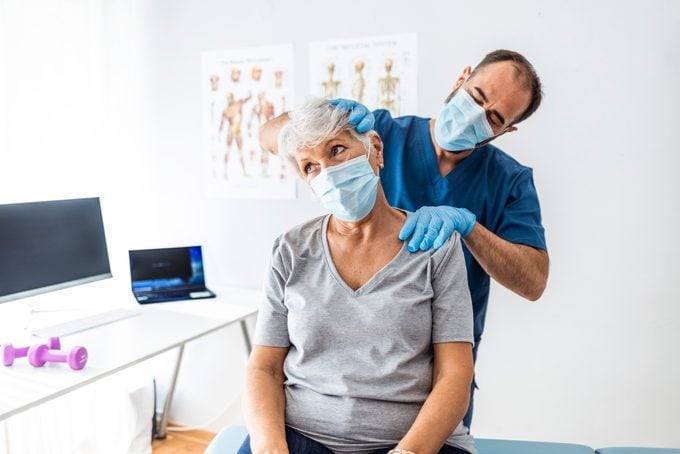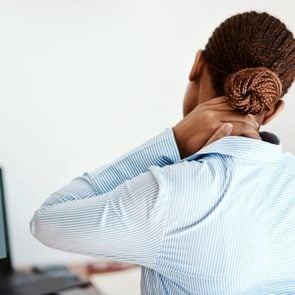A Guide to Neck Pain Symptoms, Causes, Treatments, and Relief
Updated: Aug. 30, 2021
Here's how to get rid of neck pain, from potential causes and treatments to how to prevent and manage neck pain at home.
Our editors and experts handpick every product we feature. We may earn a commission from your purchases.
On This Page
A pain in the neck
Neck pain is the fourth leading cause of disability in the United States.
It impacts 30 percent of Americans annually and at least half of people at some point in their life, according to Patrick F. Doherty, MD, a Yale Medicine neurosurgeon and assistant professor of clinical Neurosurgery, Yale School of Medicine.
While most acute cases of neck pain resolve on their own, nearly half of people with neck pain will experience future episodes.
Potential causes of neck pain
There are a variety of neck pain causes.
“With over 300 muscles in the neck, it is common to irritate or ‘over-stretch’ a muscle from overuse or overexertion such as turning the head side to side in a repetitive fashion,” adds Rahul Shah, MD, a board-certified Orthopedic Spine & Neck Surgeon.
Many episodes are self-limited, related to a muscle strain or a pulled muscle in the neck. This can occur during sports (swimming, dancing, etc.), and from everyday activities such as sleeping at an unfavorable angle or poor posture when using a computer or phone.
“Activities such as sitting at a computer, speaking on the phone, reaching overhead can cause neck pain,” says Dr. Doherty.
Additionally, neck pain can come from causes beyond the muscles and tendons within the neck, per Dr. Shah.
Other causes of neck pain can include irritation of the neck joints, arthritic bone spurs, and disc or spinal cord problems.
Injuries can also cause neck pain when bones are either injured, fractured, or dislocated. Also, you can have pain in the neck as a result of an infection or even a cancerous process.

Symptoms of neck pain
In addition to neck pain itself, other symptoms often go alongside it, according to the American Association of Neurological Surgeons:
- Pain in the arm
- Numbness or weakness in the arm or forearm
- Tingling in the fingers or hand
- Difficulty with balance and walking
- Weakness in the arms or legs
How to identify the cause of neck pain
It is often difficult to determine and differentiate the cause of neck pain, says Dr. Shah. Therefore, understanding the context in which the pain occurs can help you figure out why it’s happening.
For example, neck pain that comes from staying in one position for too long—like sleeping on an uncomfortable pillow, staring at a computer screen at an awkward angle, or looking up overhead for an extended period—may be associated with pain from a muscle that is overstretched or a neck joint that is irritated.
Alternatively, neck pain that consistently occurs when you wake up may be consistent with arthritic neck pain.
Neck pain that occurs after a head injury may have a different cause, explains Dr. Shah.
“Therefore, in short, an important part of diagnosing neck pain is determining the context in which neck pain occurs and the associated clinical findings, which can include swelling, fevers, etc.,” Dr. Shah says.
When to call a doctor
Dr. Shah explains that most ailments that affect the neck can be categorized by the “rule of twos,” which refers to different time frames: two days, two weeks, two months.
“A minor irritation in the neck should improve within a few days,” Dr. Shah says. “In this category, the common ailments include a pulled neck muscle from overuse, sleeping in an unsuitable manner, and looking up overhead for an extended period of time.”
Deeper neck irritation or problems might begin to improve in a couple weeks. “Ailments in this category included arthritic bone spurs, minor irritation to nerves in the neck.”
Within two months, injuries that involve structural areas to the neck should be showing signs of significant healing. “In this category is injury to the bones, joints, and ligaments within the neck,” he explains.
With this larger framework in mind, neck discomfort that doesn’t improve within a few weeks should be investigated further with additional evaluation with a physician and possible additional tests including X-rays or an MRI.
“With a comprehensive diagnosis, treatment regimens can be implemented,” Dr. Shah says.
If neck pain is related to an accident such as a sports injury, car accident, or any type of trauma, a person should seek medical attention immediately, urges Dr. Shah.
Dr. Doherty adds that pain associated with tingling or numbness or weakness in the arms should also be evaluated more urgently.
However, for other types of neck pain, Dr. Shaw notes that it is advisable to visit a doctor for a diagnosis and treatment if it does not improve after a few days or a week.
(This is how to fix a crick in your neck.)
How to manage neck pain at home
There are a number of ways to treat neck pain at home. However, seek help if you aren’t getting better.
“If symptoms do not resolve, medical attention should be sought,” says Dr. Doherty.
Over-the-counter medication
In the absence of arm pain, weakness, tingling, fever, or severe headache, Dr. Doherty recommends treatments with over-the-counter medication for pain and inflammation, such as aspirin, ibuprofen (Motrin), naproxen (Aleve), or acetaminophen (Tylenol).
Stretching
Additionally, stretching should be included, “especially if a discrete cause of strain is identified,” Dr. Doherty notes.
Neck flexion, neck lateral flexion, neck extension, neck rolls, and armpit stretch are examples of simple neck stretches that can help relieve pain.
Ice or heat
Dr. Doherty also suggests ice or heat, icing the area for the first 48 to 72 hours, then using heat after.
Warm showers, hot compresses, or heating pads are also effective methods of heat application.
However, be careful not to fall asleep while using a heating pad or ice bag, as it may result in a skin injury.
Massage
Dr. Doherty also suggests having someone gently massage the sore or painful areas.
Good sleep hygiene
If you have neck pain, Dr. Doherty suggests sleeping on a firm mattress and using a supportive neck pillow.
There are pillows specifically for those with neck pain that can be found at pharmacies, retail stores, or online.
Soft neck collar
Dr. Doherty suggests asking your doctor about using a soft neck collar for two to four days to relieve discomfort.
These soft neck-support devices can be found on Amazon or in most drugstores.
However, Dr. Doherty discourages people from using one any longer without taking a break, as it can weaken your neck muscles.
Acupuncture
Acupuncture can also be effective in treating neck pain, according to Dr. Doherty.
Limit activities
Dr. Doherty suggests limiting activities while you are experiencing neck pain.
However, this doesn’t mean you should be on bed rest.
For the first few days, you should take a break from your normal physical activities to help reduce symptoms, swelling, and inflammation.
Afterwards, you can gradually resume activity. However, avoid heavy lifting or twisting your neck or back for the first six weeks.
If you struggle to move your head, avoid driving.

How a doctor diagnoses neck pain
First, a doctor will observe the neck, look for signs of muscle spasms or tenderness and see pain caused by range of motion, explains Dr. Shah.
“During the physical examination, the range of motion of the neck can be assessed along with muscle and sensation testing to verify the nerves that course through the neck are functioning appropriately,” he explains.
Next, diagnostic injections could help determine the source of the pain.
If the patient’s pain is temporarily reduced following the injection, it is likely the muscle or joint is the root of the issue.
Your doctor will likely assess your muscle power, reflexes, and sensation to determine if an X-ray, CT scan, MRI, or EMG is necessary to rule out serious causes.
“EMG is a diagnostic study and stands for electromyography, which measures muscle response or electrical activity in response to a nerve’s stimulation of the muscle,” explains Dr. Shah.
During the test, one or more small needles (also called electrodes) are inserted through the skin into the muscle.
The test is used to see if nerves are being pinched or irritated as they leave the spine or as they weave through different areas of the body to get to the arms and legs.
The test is also used to evaluate the nerve function in diseases that directly affect all of the nerves of the body, he explains.
Medical treatments for neck pain
There are a number of ways a doctor can help treat serious cases of neck pain, per Dr. Shah. How effective they are is dependent on the root of the pain.
Physical therapy
For those who have primarily neck muscle irritation or irritation of arthritic bone spurs, physical therapy exercises may be of significant help.
Trigger point injections
For those who don’t achieve as much improvement with other treatments, trigger point injections can also help to control the muscles’ spasms.
“Injections that deliver medications (often a combination of steroid medication and numbing medication) to the muscles just underlying the skin are called trigger point injections,” Dr. Shah explains.
Facet injections
The second type of injections go deeper and deliver similar medications next to the joints in the spine. These are called facet injections, explains Dr. Shah.
They are used when the facet joints are irritated.
Generally, the doctor will use X-ray guidance to deliver the same anti-inflammatory and numbing medications into the joints.
This is typically an in-office procedure.
Epidural injections
Alternatively, if the damage is more severe, including pressure on the spinal nerves and spinal cord, other interventions may also be considered.
“Oftentimes, inflammation and the cascade of pain can be helped with injections of steroid medication to the areas that are compressed and irritated,” says Dr. Shah.
These injections are the third type, known as epidural injection or spinal nerve block injections.
In this case, medication is injected to block nerve signals of the spine, and they deliver anti-inflammatory medication to the areas that need it most.
Surgery
Finally, if the spinal nerves and spinal cord are still significantly compressed, surgical solutions may also be considered.
Surgical options include surgery from either the front and/or the back of the spine based on the compression location.
“Surgeries done from the front of the neck include anterior cervical decompression and fusion or disc replacement,” says Dr. Shah. “Surgery done from the back of the neck includes posterior cervical decompression and fusion or laminoplasty.”
Potential complications
Dr. Shah warns that the main complications in the spine usually relate to delays in diagnosis, especially in the event of tumor that either starts or has spread to the spine.
“Therefore, it is essential to follow up with your primary medical doctor to make sure your routine health checks are up to date,” he urges.
How to prevent neck pain
There are a number of things you can do to prevent neck pain.
One key way to prevent neck pain is by stretching.
“Stretching before and particularly after any physical fitness activity should be emphasized,” Dr. Doherty says.
If you work at a computer or a desk most of the day Dr. Doherty suggests that you:
- Make sure to stretch your neck hourly
- Use a headset to talk on the phone
- Sit comfortably in an ergonomic position
- Place all documents or books at eye level
- Avoid being on your feet for long periods of time
If you have to stand for hours each day, it can be helpful to use a stool to rest one of your feet on, alternating it periodically.
Also, make sure to wear comfortable shoes, avoiding high heels. And again, sleep on a firm mattress with a supportive pillow.
Finally, if you drive for long periods at a time, make sure to stop and get out of the car hourly to walk around.



